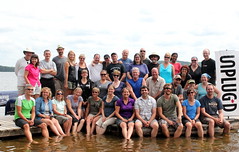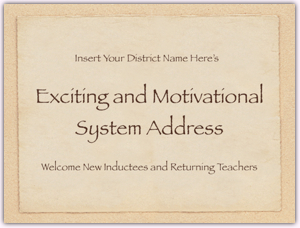

Mary Beth Hertz (@mbteach on Twitter, Philly Teacher on blogger.com) is a highly valued member of my PLN (Professional/Personal Learning Network). I met Mary Beth in Washington, DC at the annual ISTE EdTech conference — NECC09, and we have continued to maintain a valuable ongoing dialogue in the months since that time. As a dedicated and forward-looking educator in Phillidelphia, Mary Beth regularly blogs about her adventures in moving-forward the learning opportunities for her students and her personal practice.
Today Mary Beth blogged about her first day of the 2009-10 school year, some challenges encountered by her students and school, and the very important value of her PLN to her in her role. (If you are new to the concept of the PLN, Mary Beth’s post includes some excellent links to starting points in developing your own network.)
Here are my comments, as inspired by Mary Beth’s post.
Hey there, Mary Beth.
So much of what you write is reminiscent of discussions we had with folks at NECC this past June/July — the PLN movement IS gaining some traction, in no small part due to Twitter and the related social media and 2.0 explosion, but the numbers of folks who are diving in and embracing the concept seem to mirror the rush of the general educational population to embrace technology in general – that is to say, rushing very slowly. As we experienced at NECC, many of the presenters there were preaching to the converted. Presenters and attendees alike have a huge challenge in supporting the remaining majority of our colleagues in embracing both technology and the PLN concept.
Personally, I can’t believe that the limited numbers of our “local PLN members” are entirely due to differences in adoption rates of technology. When you reference your interest in discussing Educational Leadership or other professional journals versus conversations about last night’s TV shows, I can’t help but think that we’re seeing artifacts of the institutionalization of education, and a counter-intuitive de-professionalization of our role. With school/district administration providing direction on one hand, and unions exerting member-protecting influences on the other hand, (and in no way forgetting the needs of our student and their parents on the third hand), educators today can be placed into a mode of continual reaction — reacting to significant constraints, considerable pressures, and overload in terms of continually changing expectations.
Unfortunately, there is a significant difference between reaction and response — and even more so in the case of purposeful, planned response.
And it is this planned, purposeful response which can sometimes be so significantly constrained within our profession.
Add in the challenge of balancing career commitments and personal life, and we have dedicated folks who are placed in a position of having very little time to focus on self-directed professional growth. Unfortunately, the traditional district models of Professional Development (PD, “in-service,” – shot in the arm) continue to be the norm. (I recall a statistic from a few years back which referenced an approximate annual 5% expenditure towards staff education/training in business/industry — and an incredibly disproportionate <1% allocation in the Education sector. While I have no recent data, my guess would be that we’re no better, and most likely, even worse, than before.) Too many PD models continues to reflect the historic top-down, worker-as-cog model. Cogs are part of the larger machine — they aren’t supposed to re-define their roles or respond independently or even collaboratively to change the machine’s function. (Unless they’re parts of a Deming-type machine. Which tends not to be the in-effect model within schools.)
When I look at the efforts of Sheryl Nussbaum-Beach and Will Richardson with their Professional Learning Practice (“PLP”) initiative <http://plpnetwork.com/>, I see a long-term, team-oriented, job-embedded approach which has the potential to achieve a significant transformational result — similar to the effects obtained through university-level PD courses. But even these effects require buy-in and commitment, and this is where the influences referenced above can really interfere with full engagement.
As much as I’d like to see an immediate and significant development of effective “local PLNs,” Twitter-networks, online sharing networks, and technology-mediated collaboration, we need both the vision and direction from education bureaucrats and educational administration to support such efforts on an institutional scale, and a shift in perception and engagement from front line educators towards a clearer understanding of how our need for greater empowerment must come from within. Not insignificant in this is the need for the networks to be valued and organized by the individual in response to their needs and interests. (And by-the-by, moving forward, such is the reality for our students, as well.)
My path through my early education followed the traditional model as described in Richard N. Bolles’ book, The Three Boxes of Life (the three boxes being Education, Work, and Retirement), but my early formative work experiences in education, coupled with some fortuitous connections during my education degree, deeply ingrained the “life-long learner” philosophy — a belief that continually drives my exploration of learning, educating and edTech. This “learning for life” belief (and the development of complementary skills to support it) is SO critical for today’s educators and students alike. Without this understanding, and without the skills and time to follow through, there can be no significant personally-planned response for ongoing, professional development.
Ontario colleague Doug Peterson commented on an earlier post here on edVisioned.ca, and referenced the very real benefits that new information communication technologies offer in allowing us to connect and develop our collective visions and skills in the absence of significant local direction/collaboration. It may be, that in the interim, those of us looking to reach forward and “push back the outside of the envelope” will need to continue to draw strength and support from the at-distance PLN. For as we work locally to establish frameworks and work to support our colleagues as change and technology marches on, there is no doubt in my mind that the requisite source of enlightenment and empowerment for this sometimes daunting task will be found in the online PLN revolution.

 Mary Beth Hertz (@mbteach on Twitter, Philly Teacher on blogger.com) is a highly valued member of my PLN (Professional/Personal Learning Network). I met Mary Beth in Washington, DC at the annual ISTE EdTech conference — NECC09, and we have continued to maintain a valuable ongoing dialogue in the months since that time. As a dedicated and forward-looking educator in Philadelphia, Mary Beth regularly blogs about her adventures in moving-forward the learning opportunities for her students and her personal practice.
Mary Beth Hertz (@mbteach on Twitter, Philly Teacher on blogger.com) is a highly valued member of my PLN (Professional/Personal Learning Network). I met Mary Beth in Washington, DC at the annual ISTE EdTech conference — NECC09, and we have continued to maintain a valuable ongoing dialogue in the months since that time. As a dedicated and forward-looking educator in Philadelphia, Mary Beth regularly blogs about her adventures in moving-forward the learning opportunities for her students and her personal practice.
Today Mary Beth wrote a wonderful blog post entitled “Why Everyone Needs a Great PLN,” about her first day of the 2009-10 school year, some challenges encountered by her students and school, and the very important value of her PLN to her in her role. (If you are new to the concept of the PLN, Mary Beth’s post includes some excellent links to starting points in developing your own network.)
Here are my comments, as inspired by Mary Beth’s post.
Hey there, Mary Beth.
So much of what you write is reminiscent of discussions we had with folks at NECC this past June/July — the PLN movement IS gaining some traction, in no small part due to Twitter and the related social media and 2.0 explosion, but the numbers of folks who are diving in and embracing the concept seem to mirror the rush of the general educational population to embrace technology in general – that is to say, rushing very slowly. As we experienced at NECC, many of the presenters there were preaching to the converted. Presenters and attendees alike have a huge challenge in supporting the remaining majority of our colleagues in embracing both technology and the PLN concept.
Personally, I can’t believe that the limited numbers of our “local PLN members” are entirely due to differences in adoption rates of technology. When you reference your interest in discussing Educational Leadership or other professional journals versus conversations about last night’s TV shows, I can’t help but think that we’re seeing artifacts of the institutionalization of education, and a counter-intuitive de-professionalization of our role. With school/district administration providing direction on one hand, and unions exerting member-protecting influences on the other hand, (and in no way forgetting the needs of our student and their parents on the third hand), educators today can be placed into a mode of continual reaction — reacting to significant constraints, considerable pressures, and overload in terms of continually changing expectations.
Unfortunately, there is a significant difference between reaction and response — and even more so in the case of purposeful, planned response.
And it is this planned, purposeful response which can sometimes be so significantly constrained within our profession.
Add in the challenge of balancing career commitments and personal life, and we have dedicated folks who are placed in a position of having very little time to focus on self-directed professional growth. Unfortunately, the traditional district models of Professional Development (PD, “in-service,” – shot in the arm) continue to be the norm. (I recall a statistic from a few years back which referenced an approximate annual 5% expenditure towards staff education/training in business/industry — and an incredibly disproportionate <1% allocation in the Education sector. While I have no recent data, my guess would be that we’re no better, and most likely, even worse, than before.) Too many PD models continues to reflect the historic top-down, worker-as-cog model. Cogs are part of the larger machine — they aren’t supposed to re-define their roles or respond independently or even collaboratively to change the machine’s function. (Unless they’re parts of a Deming-type machine, which tends not to be the in-effect model within schools.)
“To successfully respond to the myriad of changes that shake the world, transformation into a new style of management is required. The route to take is what I call profound knowledge—knowledge for leadership of transformation.” – W. Edwards Deming

Powerful Learning Practice network
When I look at the efforts of Sheryl Nussbaum-Beach and Will Richardson with their Powerful Learning Practice (“PLP”) initiative, I see a long-term, team-oriented, job-embedded approach which has the potential to achieve a significant transformational result — similar to the effects obtained through university-level PD courses. But even these effects require buy-in and commitment, and this is where the influences referenced above can really interfere with full engagement.
As much as I’d like to see an immediate and significant development of effective “local PLNs,” Twitter-networks, online sharing networks, and technology-mediated collaboration, we need both the vision and direction from education bureaucrats and educational administration to support such efforts on an institutional scale, and a shift in perception and engagement from front line educators towards a clearer understanding of how our need for greater empowerment must come from within. Not insignificant in this is the need for the networks to be valued and organized by the individual in response to their needs and interests. (And by-the-by, moving forward, such is the reality for our students, as well.)
 My path through my early education followed the first third of the traditional model as described in Richard N. Bolles’ book, The Three Boxes of Life (the three boxes being Education, Work, and Retirement), but my early formative work experiences in education, coupled with some fortuitous connections during my education degree, deeply ingrained the “life-long learner” philosophy — a belief that continually drives my exploration of learning, educating and edTech. This “learning for life” belief (and the development of complementary skills to support it) is SO critical for today’s educators and students alike. Without this understanding, and without the skills and time to follow through, there can be no significant personally-planned response for ongoing, professional development.
My path through my early education followed the first third of the traditional model as described in Richard N. Bolles’ book, The Three Boxes of Life (the three boxes being Education, Work, and Retirement), but my early formative work experiences in education, coupled with some fortuitous connections during my education degree, deeply ingrained the “life-long learner” philosophy — a belief that continually drives my exploration of learning, educating and edTech. This “learning for life” belief (and the development of complementary skills to support it) is SO critical for today’s educators and students alike. Without this understanding, and without the skills and time to follow through, there can be no significant personally-planned response for ongoing, professional development.
Ontario colleague Doug Peterson commented on an earlier post here on edVisioned.ca, and referenced the very real benefits that new information communication technologies offer in allowing us to connect and develop our collective visions and skills in the absence of significant local direction/collaboration. It may be, that in the interim, those of us looking to reach forward and “push back the outside of the envelope” will need to continue to draw strength and support from the at-distance PLN. For as we work locally to establish frameworks and work to support our colleagues as change and technology marches on, there is no doubt in my mind that the requisite source of enlightenment and empowerment for this sometimes daunting task will be found in the online PLN revolution.






 The Future is Already Here … it’s just not very evenly distributed.
The Future is Already Here … it’s just not very evenly distributed.

 Mary Beth Hertz (@mbteach on Twitter, Philly Teacher on blogger.com) is a highly valued member of my PLN (Professional/Personal Learning Network). I met Mary Beth in Washington, DC at the annual ISTE EdTech conference — NECC09, and we have continued to maintain a valuable ongoing dialogue in the months since that time. As a dedicated and forward-looking educator in Phillidelphia, Mary Beth regularly blogs about her adventures in moving-forward the learning opportunities for her students and her personal practice.
Mary Beth Hertz (@mbteach on Twitter, Philly Teacher on blogger.com) is a highly valued member of my PLN (Professional/Personal Learning Network). I met Mary Beth in Washington, DC at the annual ISTE EdTech conference — NECC09, and we have continued to maintain a valuable ongoing dialogue in the months since that time. As a dedicated and forward-looking educator in Phillidelphia, Mary Beth regularly blogs about her adventures in moving-forward the learning opportunities for her students and her personal practice.
 My path through my early education followed the first third of the traditional model as described in Richard N. Bolles’ book, The Three Boxes of Life (the three boxes being Education, Work, and Retirement), but my early formative work experiences in education, coupled with some fortuitous connections during my education degree, deeply ingrained the “life-long learner” philosophy — a belief that continually drives my exploration of learning, educating and edTech. This “learning for life” belief (and the development of complementary skills to support it) is SO critical for today’s educators and students alike. Without this understanding, and without the skills and time to follow through, there can be no significant personally-planned response for ongoing, professional development.
My path through my early education followed the first third of the traditional model as described in Richard N. Bolles’ book, The Three Boxes of Life (the three boxes being Education, Work, and Retirement), but my early formative work experiences in education, coupled with some fortuitous connections during my education degree, deeply ingrained the “life-long learner” philosophy — a belief that continually drives my exploration of learning, educating and edTech. This “learning for life” belief (and the development of complementary skills to support it) is SO critical for today’s educators and students alike. Without this understanding, and without the skills and time to follow through, there can be no significant personally-planned response for ongoing, professional development. I recall my very first “new teacher induction meeting,” all those years ago (19, I think), when the then-Director of Education for the district assembled all of the new hires together during the last week of August (right about now, say) and welcomed us with a visionary and passionate speech about the careers upon which we were about to embark. I remember remarking at the time that he was one of the most eloquent and dynamic speakers I had ever heard, and was conscious at the time of his powerful use of metaphor and careful, poet’s choice of words in crafting his talk. I was impressed to the point that I was motivated to go up and speak with him when the session ended. (Imagine that, a new teacher, approaching the Director of Education on the first day of induction — and yet, why not?). Our conversation continued from the meeting room along the hallway, and concluded at his office, where he picked up a recently released book of essays on literacy from his desk and offered it to me to take away and use with my students. Imagine that. Welcome, and here’s a Vision, and here’s a Book of Inspiration.
I recall my very first “new teacher induction meeting,” all those years ago (19, I think), when the then-Director of Education for the district assembled all of the new hires together during the last week of August (right about now, say) and welcomed us with a visionary and passionate speech about the careers upon which we were about to embark. I remember remarking at the time that he was one of the most eloquent and dynamic speakers I had ever heard, and was conscious at the time of his powerful use of metaphor and careful, poet’s choice of words in crafting his talk. I was impressed to the point that I was motivated to go up and speak with him when the session ended. (Imagine that, a new teacher, approaching the Director of Education on the first day of induction — and yet, why not?). Our conversation continued from the meeting room along the hallway, and concluded at his office, where he picked up a recently released book of essays on literacy from his desk and offered it to me to take away and use with my students. Imagine that. Welcome, and here’s a Vision, and here’s a Book of Inspiration. Shortly thereafter we lost close to half of our PA days, and (regardless of that) never since have we had an opportunity to assemble as a whole district group to hear the Director speak and feel that common bond of pulling together with a shared and enumerated vision. The Director still has an address each August for the school administrators and central office staff, but it’s by invitation only, and the closest we get to it is the chance to download a narrated Powerpoint slide deck. Maybe this year’s address will be video recorded and posted for all to view, but somehow, something is lost without the face-to-face oration, without that opportunity to physically gather together and participate, and without that serendipitous moment to maybe have a chat with the Director.
Shortly thereafter we lost close to half of our PA days, and (regardless of that) never since have we had an opportunity to assemble as a whole district group to hear the Director speak and feel that common bond of pulling together with a shared and enumerated vision. The Director still has an address each August for the school administrators and central office staff, but it’s by invitation only, and the closest we get to it is the chance to download a narrated Powerpoint slide deck. Maybe this year’s address will be video recorded and posted for all to view, but somehow, something is lost without the face-to-face oration, without that opportunity to physically gather together and participate, and without that serendipitous moment to maybe have a chat with the Director.